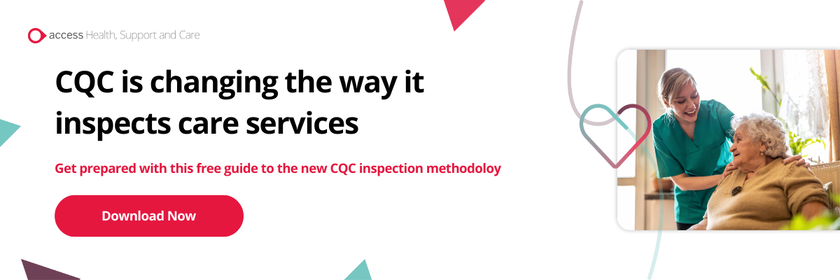New CQC Inspection Framework and Provider Portal
The CQC single assessment framework is now live for all adult social care
providers across the country and the new CQC provider portal is currently live for selected providers, with limited functionality, e.g. restricted to some notification types.
With the Single Assessment Framework, the CQC is aiming for a more dynamic and data-led strategy that puts people’s experiences at the forefront of regulation and the heart of the assessment framework.
As a care provider, it’s crucial that you understand the new inspection regime and how these significant changes to the way they regulate and inspect may affect you. This article has been created to help you understand more about the CQC's new inspection and assessment framework and the background to these changes.
You can also download this comprehensive guide, and sign up for our compliance experts' monthly updates on everything CQC.
How Often Does CQC Inspect?
All adult social care providers are monitored by the CQC with regular inspections. Currently, these will occur depending on the provider's previous rating and CQC analysis risk. These reviews are put in place to ensure that health and social care services are providing people with care that is safe, effective, caring, responsive and well-led.
Part of an inspection includes listening to people; people receiving care, families, members of staff and other health and social care professionals. They also encourage and listen to feedback and concerns from people receiving care and those who have loved ones in the facility. If there’s a problem or standards aren’t being met, then the CQC will take appropriate action to ensure people receive care in line with the health and social care act regulations.

CQC New Inspection Model
The changes implemented by the CQC will be introduced in phases and they will be clear about how they will directly affect health and care providers. The new framework is being published currently so providers and other stakeholders have time to familiarise themselves with the changes.
The new CQC assessment framework emphasises safety cultures that can learn and improve over time, with systems in place that plan and deliver safe, person-centred care.
The rating scale of Outstanding, Good, Requires Improvement and Inadequate are staying the same, as are the CQC’s five key questions (Safe, Effective, Caring, Responsive, Well-led).
But, crucially, how CQC will assess if you are meeting those 5 standards and how your overall rating will be determined is changing. There will be significant changes to:
- The inspection and rating methodology
- A new evidence-scoring system
- Factual accuracy
- CQC inspector roles
You can see a summary of the 6 changes to expect below:
1. CQC Single Assessment Framework
CQC's Single Assessment Framework is a big change to how the CQC functions across health and social care. The CQC has always had three assessment frameworks; one for hospitals, one for adult social care and one for primary medical services. Now, a single assessment framework has been developed by the CQC to streamline and simplify the assessment process. The new single assessment model will consist of one overall set of expectations, making it easier to establish one clear understanding of what defines ‘quality’ care and ‘good’ service.
2. CQC Quality Statements and Topic Areas
The CQC has laid out the new single assessment framework in the form of a pyramid. This can be used to guide care providers through the nitty-gritties of their assessment criteria. At the top of the pyramid sits the 5 Key Questions, which are used to ask whether your service has been safe, effective, caring, responsive and well-led. This is followed by CQC Quality Statements and then evidence.
The big change is that as of April 2023 the CQC Key Lines of Enquiry (KLOEs), the KLOE prompts and the ratings are all being retired.
To answer the 5 key questions, CQC will assess you against the new topic areas and quality statements collecting evidence in a range of areas including:
- People’s experience of health and care services
- Feedback from staff and leaders
- Feedback from partners
- Observation
- Processes
- Outcomes
To begin with, CQC said the new assessment framework would be put into operation in early 2023. However, they have recently shared that they are re-examining their timescales for implementation.
Our January 2023 Regulations and Compliance Update contains the CQCs updated timeline as of January 2023. This newsletter is released every month and contains all of the CQC news you need to keep on top of their changes and timescales.
3. Changes to the Nature and Timing of Inspections
Currently, the CQC’s assessment of service is carried out via an inspection. This will lead to judgements in the five key questions and then your overall rating. The frequency of current CQC inspections is often based on the previous rating of a service and/or CQC’s analysis of the current risk associated with your service.
While inspections will remain a crucial element of CQC assessment, the new regulatory model states that the CQC will carry out a rolling assessment of quality and risk. This means that inspections will not be the only way that CQC assess your service. They will become a part of a broader style of ongoing assessment that will include:
- Different ways of understanding and assessing the experiences of people
- Hearing from staff and leaders
- Direct monitoring activities
- Evidence you submit to CQC
- Surveys and focus groups.
Each area of the new style of assessment methodology could lead to a change in your rating. The current ambition of the CQC is to update the information they hold on a service across all of the required quality statements and evidence categories within 2 years.
Please note that site visits will still be taking place. However, the CQC do plan to make a more iterative assessment of service and will use these new methods to form a picture over time. By moving away from the ‘one-size-fits-all’ methods that are currently in place, they’re hoping to provide a more up-to-date view of quality and safety while increasing responsiveness towards signs of risk.
4. The New Scoring System
The 4 ratings CQC use to describe the quality of care; Outstanding, Good, Requires improvement or Inadequate will remain in place.
Different quality statements are likely to be assessed on an ongoing basis as CQC move away from inspecting and making judgements at a single point in time. Following an assessment, the evidence scoring framework will be used, which has been developed by CQC to provide a consistent and transparent view of quality and determine your rating.
The evidence consists of an analysis of information that CQC already holds, alongside their onsite/off-site assessment activity. The evidence findings will determine the score for each quality statement:
- 4 = Evidence shows an exceptional standard of care
- 3 = Evidence shows a good standard of care
- 2 = Evidence shows shortfalls in the standard of care
- 1 = Evidence shows significant shortfalls in the standard of care
While the quality statements clearly describe the standards of care people should expect, and providers need to ‘live up to’, evidence in each required evidence category will be used to assess a particular quality statement.
This means that scores for different quality statements will be updated at different times leading to a more current and up-to-date view of quality. This may lead to changes in your rating. To make their judgement CQC will:
- Review evidence types within the required evidence categories for each quality statement.
- Apply a score to each of these evidence categories.
- Combine these required evidence category scores to give a score for the related quality statement.
- Combine the quality statement scores to give a total score for the relevant key question.
- This score generates a rating for each key question.
- Aggregate the key question ratings to give the overall rating.
Ratings will be the only thing published at first, but the scores are intended to be published in the future. CQC say the new scoring system will better support consistency and transparency in their judgements whether you are a service in Newcastle or Newquay. Rather than the ‘once and done’ style of current inspections, future assessments will often be much shorter and much more frequent covering different aspects of the quality and safety of your service.
Once the new scoring system is implemented providers should be able to see how CQC have reached their judgments. The scoring system will also help providers, CQC and the public see if the quality of care is moving up or down within a rating. It will also show if a service is getting close to a different rating. For example, for a provider with a ‘good’ rating, the score will be able to show if it’s closer to ‘outstanding’ or closer to ‘needs improvement’.
5. Better Turnaround Time
Finally, the turnaround time is the next change you should expect to their regulatory model. The CQC has recognised that providers have to wait a long time to find out their inspection results, so have aimed to streamline and speed up their reporting processes to improve turnaround times. Reports will be shorter and the changes in the assessing methodology mean they will provide a more up-to-date view of the quality and safety of your service. They will also be published with a range of different information such as your evidence scores and how you compare to other similar providers nationally.
For most providers, these changes won’t be implemented until January 2023, but early adopters would have begun changing their ways from August 2022.
6. The Factual Accuracy Process
The sixth and final change is that CQC says they are building on the current factual accuracy process to improve the current system. The new process is currently explained as ‘Review and submit further evidence.’ However, CQC is currently consulting on this and has yet to properly describe what the process will look like, or what it will be called. Providers will be able to see how their evidence has been scored in the new provider portal and it is likely that you will ‘review and submit further evidence’ in this way.

CQC New Approach to Inspections Checklist
CQC has said that they will provide at least 2-3 months’ notice for providers in terms of implementing the new Single Assessment Framework. They are currently developing guidance on this. Here is a CQC inspection checklist for how you as a provider can prepare for the new CQC inspection approach:
- Sign up for all of the information from the CQC – this includes adult social care bulletins, their YouTube channel, blogs, relevant webinars and digital engagement platforms.
- Review the new quality statements (QS) in terms of your existing quality assurance/audits, systems of work, etc. to identify any gaps between what you do currently, and what you will need to adapt or add to ensure your compliance with the quality statements. For example:
- Learning Culture (in safety)
- Safe Systems, Pathways and Transitions
- Environmental Sustainability
- Workforce Wellbeing and Enablement.
The above are all quality statements with a new approach or a different emphasis CQC will explore as part of their rolling cycle of assessment. In fact, when you compare the KLOEs to the QS it is evident that CQC have given a great deal of thought to what they will be assessing to assure themselves of your quality and safety.
There is time now for you to do the same. Where there are gaps, consider what new systems, practices and training may be required. This will provide a high level of assurance to the regulator that your organisation has the governance systems and audit processes required to ensure people receive safe, effective, caring, responsive and well-led care and support.
Remember if you are inspected before the new framework has gone live, and unless you are an early adopter and notified as such by CQC, you will be inspected under the existing inspection regime i.e. the KLOEs. However, the work you do to prepare for the new assessment framework can only add to the robustness of your existing governance, so don’t let that be a barrier to getting started.
- Use Co-production to help you rectify gaps in your current systems and practice. You can find out more about co-production at SCIE and this not only means that you truly involve people in the development of your service but will provide you with a great deal of positive evidence for CQC.
- Review your current policies and procedures and agree on how to align them with the new quality statements and the six evidence categories, especially where policies may not yet exist g. Environmental Sustainability.
- See if there are any changes required in your assessment, care planning/reviews and record keeping to ensure they fully demonstrate your compliance with the QS and Regulations, as well as how they help you to evidence compliance within the new inspection framework.
- Communicate with your teams – how you share information about the new CQC assessment framework, the QS and what the change means for them and the service. Reassure staff that a lot of what CQC will ask will feel very familiar, after all, it's still about high-quality, safe, person-centred care. However, there are a lot of differences in how CQC will gather evidence and the new commitments (QS) they expect of providers. What opportunities do you have to start discussing this with teams, and how can you involve staff in your co-production ideas?
- Review your methods of evidencing your best practice. CQC will gather evidence in different ways and at different times, for example, while on-site inspections will still occur, CQC will seek other evidence in different ways including you providing evidence to them via the new provider portal. Keep up to date with CQC to ensure you learn more about what this may look and feel like as soon as CQC release further information.
- Monitor your engagement – there will be an increased focus from CQC on not only how you seek feedback, but how this is used to continuously develop and improve your service, and people’s experiences. Make sure you can provide evidence of this and on that note,
- Step up your engagement processes – how do you seek and obtain feedback, how frequently, what do you ask, and what does it tell you? Are you using it consistently to improve your service, how do you know it’s been done, and what difference it has made? Remember to ask the people using the service what difference they think it has made!
- Learn more about the new ways of working, how to maintain your compliance with CQC, and how to evidence your focus on the individual at the Duffy & Shaw Consultancy Webinar CQC Regulatory Compliance and Best Practice.
What is Staying the Same?
The Health and Social Care Act 2008 (Regulated Activities) Regulations 2014 and the Fundamental Standards will not be changing and have remained in place. The CQC will also continue to use:
- The five key questions – safe, effective, caring, responsive and well-led
- The four-point rating scale – outstanding, good, requires improvement and inadequate
What Will Happen Next?
The CQC has published the six categories of evidence that they will collect to make their decisions. The evidence categories are:
- People’s experience of health and care services
- Feedback from staff and leaders
- Feedback from partners
- Observation
- Processes
- Outcomes
Evidence will be scored against the relevant quality statement and key questions, which will determine the overall rating of the care business. The evidence-scoring system will be published soon to promote better transparency. The CQC say their judgements will be more consistent as a result of these changes, but it will take time to see if the new method is more successful for providers.
Steps You Should Take
CQC inspections can be a stressful time for care staff, so keeping your team informed and sharing relevant information will support their understanding of the changes as they emerge and the insight will take the pressure off them. Signing up for the CQC regular provider newsletter and registering for their webinar updates can be a great way to keep up-to-date, alongside checking their dedicated page often.

Prepare For the New CQC Inspection Process
Following the above steps is key to preparing yourself and your team for the new inspection process and ensuring these new standards are being met.
You can keep up to date with the latest changes as they happen via our CQC Information Hub.
One of the best ways you can prepare your care service and care team for the CQC new inspection framework is to start implementing tools that will improve compliance, quality and your CQC rating.
With The Access Group, you can find a complete suite of software that will help you manage your care service, improve your care quality and increase operational efficiency. Our Care Compliance software will help you audit and improve care quality, giving you the tools you need to boost your CQC rating. Meanwhile, our Care Policies and Procedures software will help ensure you maintain regulatory compliance at all times.
Contact us today to find out more information about our care management solutions.
We know how effective Access Care Compliance can be and we desire to assist others, so they can experience the benefits of it too. Don't just take it from us, here are some quotes and stats from New Directions, who use the system:


